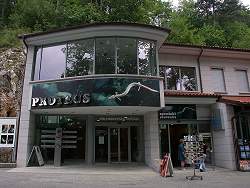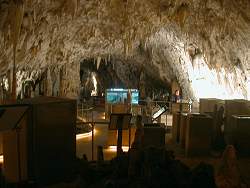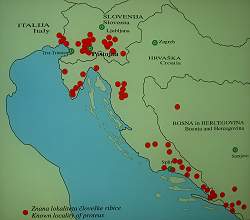Vivarium
Vivarium Proteus - Speleobiološka Postaja - Speleobiological Station
Useful Information


| Location: | In Postojna, 1 km from the centre. From Postojna exit follow road to the city, after 1 km turn right into Postojna. In Postojna city center turn left, vast parking lots at the city limits. Well signposted. 50 km south of Ljubljana. |
| Open: |
APR to JUN daily 10-16. JUL to AUG daily 9-18. SEP daily 9-17. OCT daily 10-16. NOV to MAR daily 10-15. [2023] |
| Fee: |
Adults EUR 11.50, Children (6-16) EUR 6.90, Children (0-5) EUR 1, Students (-25) EUR 9.20. [2023] |
| Classification: |
 Karst Cave Karst Cave
 Cave and Karst Museums Cave and Karst Museums
 Olm Proteus anguinus Olm Proteus anguinus
 Leptodirus hochenwartii
Historic cave entrance. Leptodirus hochenwartii
Historic cave entrance.
|
| Light: |
 Electric Light Electric Light
|
| Dimension: | n/a |
| Guided tours: | D=45 min. |
| Photography: | |
| Accessibility: | |
| Bibliography: | |
| Address: |
Postojnska jama d.d., Jamska cesta 30, 6230 Postojna, Tel: +386-5-700-01-00.
E-mail: |
| As far as we know this information was accurate when it was published (see years in brackets), but may have changed since then. Please check rates and details directly with the companies in question if you need more recent info. |
|
History
Description




Located right at the cave entrance of
 Postojnska Jama, the Vivarium is an interesting completion of the Postojna experience.
It includes numerous true cave animals, but also a very interesting archaeological profile in the historic cave entrance, and a unique possibility to have a look at the historic graffiti on the white cave walls and speleothems.
This is an old cave entrance of Postojna cave which is not used anymore for cave tours.
The cave train starting at the nearby entrance of Postojnska jama uses a parallel passage and an artificial tunnel to enter the cave.
Postojnska Jama, the Vivarium is an interesting completion of the Postojna experience.
It includes numerous true cave animals, but also a very interesting archaeological profile in the historic cave entrance, and a unique possibility to have a look at the historic graffiti on the white cave walls and speleothems.
This is an old cave entrance of Postojna cave which is not used anymore for cave tours.
The cave train starting at the nearby entrance of Postojnska jama uses a parallel passage and an artificial tunnel to enter the cave.
This underground museum was intended to explain the life of true cave animals, troglobionts, to the visitors. This is difficult, as those animals are rather strange, and most of them are very small and hard to see. Thus, a visit starts with a very interesting movie about cave animals which is shown in English or Slovenian. After this explanation, the visitor enters the cave through an airtight lock.
The first stop is a profile of the cave sediments in the entrance. To build the path, they had to cut through the cave floor, which revealed many details about the history of the cave, geologic as well as archaeological facts. Now a pretty nice side passage shows interesting speleothems like stalactites, stalagmites and rimstone dams. As this is not a guided cave tour of Postojna cave, the visitor has enough time to have a look at them. There is a round trip and lots of explanatory plates, so the visitor strolls around and has the chance to have a close look at anything he’s interested in.
The Vivarium with the living animals is located in a bigger passage or small chamber.
Here are numerous aquariums and terrariums with cave animals.
There are
 olms
(Proteus anguinus), amphibic salamanders living in caves all around.
These are probably the best known and most spectacular cave animals.
They are known since centuries, and the locals sold them to visitors when they caught them in springs and wells.
With their arms and legs they resemble humans and are also dubbe human fish.
olms
(Proteus anguinus), amphibic salamanders living in caves all around.
These are probably the best known and most spectacular cave animals.
They are known since centuries, and the locals sold them to visitors when they caught them in springs and wells.
With their arms and legs they resemble humans and are also dubbe human fish.
There is also a pool with olms on the tour through Postojna, but it is to bright there and the animals are always in stress. So they thought this would be an animal-friendly alternative. Unfortunately people did not accept the Vivarium at first presumably a result of the original, rather unwieldy name Speleobiološka Postaja (Speleobiological Station). Or because there was an additional fee. Or because there was not enough time when visitors came with a tour operator. Whatever the reason was, visitors complained and there are again olms in the Postojna pool. Nevertheless, here they are in an almost natural environment.
The second most important cave animal is a small blind bug, only 8 mm long with a voluminous body. This bug called Leptodirus hochenwartii, was discovered in 1831 by accident. There are some differences between this bug and its relatives outside caves, so this was the first time the differences between cave animals and other animals were discovered and described. So this was the first true troglobiont living on land discovered ever, and it has its place in the history of speleology.
The Vivarium is a sort of museum, but also a little like a zoo. This is rather difficult, as true troglobionts, animals living in the darkness of caves, do not like light. Most of them are extremely sensitive to any change in their environment. This includes light, temperature, humidity, and of course the noise of the visitors. So they do not really like the climate in this station, which is influenced by the proximity to the entrance and the visitors. The airtight lock at the entrance is necessary, but not sufficient. So the result is a continuous demand on new animals to fill the zoo, and continually animals die in the station. Other animals, like the proteus are kept in the aquarium for some time an then released. So the station is actually not environment friendly and not friendly to its inhabitants. On the other hand, this is the only place on Earth were visitors can have a look on this extremely strange cave live, so we recommend a visit very much.
 Search DuckDuckGo for "Vivarium Postojna"
Search DuckDuckGo for "Vivarium Postojna" Google Earth Placemark
Google Earth Placemark Vivarium, official website (visited: 20-JAN-2023)
Vivarium, official website (visited: 20-JAN-2023) Index
Index Topics
Topics Hierarchical
Hierarchical Countries
Countries Maps
Maps